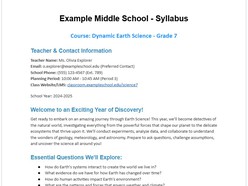
Study Aids & Notes
Elevate your studies with free Google Docs templates for note-taking & learning. Boost comprehension with study guides, organizers, and more. Download & customize!

Elevate your studies with free Google Docs templates for note-taking & learning. Boost comprehension with study guides, organizers, and more. Download & customize!

Download free, editable syllabus templates for Google Docs. Perfect for middle school, high school & college courses. Easily outline rules, grading & topics.
Efficient classroom management and impactful instruction are foundational to student success. Digital tools, particularly collaborative platforms like Google Docs, offer educators powerful ways to streamline administrative tasks, enhance lesson delivery, and foster clear communication. This guide outlines how to approach organizing educational materials and planning instruction, highlighting how structured templates can amplify these efforts.
Why it matters: Clear, accessible documentation sets expectations, provides roadmaps for learning, and ensures consistent communication with students and parents.
Key Documents & Their Purpose:
Syllabus: A comprehensive overview of a course, including learning objectives, topics, grading policies, classroom rules, and contact information. It serves as a contract and a primary reference point.
Lesson Plans: Detailed outlines for daily or weekly instruction, covering objectives, activities, materials, differentiation strategies, and assessment methods. They ensure structured and purposeful teaching.
Student Planners/Organizers: Tools (digital or physical) that help students track assignments, deadlines, and study schedules, fostering responsibility and time management.
Rubrics & Assessment Criteria: Clearly defined standards for evaluating student work, promoting transparency and consistent grading. They help students understand expectations for quality.
Communication Logs/Templates: Standardized formats for communicating with parents about student progress, behavior, or upcoming events, ensuring professionalism and efficiency.
How Templates Help: Pre-formatted templates for these documents provide a consistent structure, ensure all essential components are included, and save significant preparation time. They allow educators to focus on content and customization rather than basic formatting.
Why it matters: Thoughtful planning ensures curriculum coverage, alignment with standards, and engaging learning experiences.
Levels of Planning:
Yearly/Curriculum Mapping: A broad overview of units, key concepts, and skills to be covered throughout the academic year. This provides the "big picture."
Unit Planning: Developing a cohesive set of lessons around a specific theme or topic, including essential questions, learning targets, major assessments, and resources.
Weekly/Daily Lesson Planning: Detailing specific learning activities, instructional strategies, differentiation for diverse learners, and formative assessments for each class session.
Key Considerations in Planning:
Learning Objectives: What should students know or be able to do by the end of the lesson/unit?
Engagement Strategies: How will student interest be captured and maintained?
Differentiation: How will instruction be adapted to meet the needs of all learners (e.g., varying readiness levels, learning styles, language abilities)?
Assessment: How will student understanding be measured (formative and summative)?
Resource Management: What materials, technology, or tools will be needed?
How Templates Help: Lesson plan templates, unit plan frameworks, and curriculum map outlines offer structured formats to guide the planning process. They prompt consideration of all critical instructional components and facilitate collaboration if planning with colleagues.
Why Google Docs is a valuable tool for educators:
Accessibility & Collaboration: Documents can be accessed from any device with an internet connection. Real-time collaboration allows for co-planning lessons or sharing resources with colleagues.
Version History: Easily track changes and revert to previous versions of documents, crucial for iterative planning.
Easy Sharing: Share syllabi with parents, lesson plans with administrators, or collaborative documents with students using simple sharing links and permission settings.
Integration with other Google Workspace tools: Seamlessly link to Google Slides presentations, embed Google Forms for quizzes, or pull data from Google Sheets.
Templates for Efficiency: Start with a pre-designed template to save time on formatting and ensure all necessary sections are included.
Making the Most of It:
Organize educational documents in Google Drive using clear folder structures.
Utilize commenting features for feedback on lesson plans or student work.
Explore add-ons that enhance functionality for educators (e.g., for creating rubrics, managing citations).
Fostering an Organized and Purposeful Learning Environment
By strategically planning and utilizing digital tools and well-structured templates, educators can create a more organized, efficient, and effective learning environment. This allows more time and energy to be dedicated to direct student interaction, fostering deeper understanding and engagement.